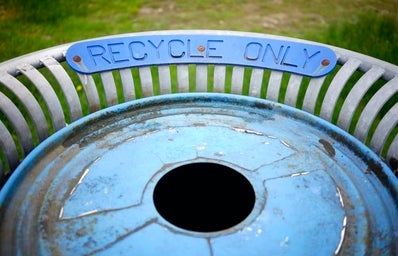We all know them: AU’s several different types of trash cans, all scattered across campus. Many of us have a love-hate relationship with them; they seem useful on paper, but it’s not always easy to know which bin we’re supposed to throw away our trash in.
Rather than just implementing the more standard sets of landfill and recycling bins, AU has landfill, mixed recycling, and compost bins, as well as respective recycling bins for batteries, ink cartridges, and plastic bags. Every spring and fall, the university holds special events for E-Waste collection, where printers, laptops, and similar electronics can be thrown away, and the university library even collects E-Waste to recycle it for you.
All of this contributes toward AU’s policy of implementing sustainable practices in order to reduce waste and send as little as possible (eventually none at all) to landfills; these bins are a physical manifestation of the university’s plans to reduce waste and maintain its green status.
Today, landfills are overflowing with the several pounds of waste the average person produces daily, an issue that has led to both major atmospheric and hydrological problems. However, trends illustrated by the EPA show there’s been a decrease in municipal solid waste generation per capita since the 1990’s, as well as an increase in percent recycling and composting, indicating that people are becoming more conscientious of their waste overall.
While AU’s trash cans are great in theory, many students don’t know what exactly can be thrown away in each bin, even with the brief descriptions on the sides of the cans. A fear of inadvertently contaminating the wrong bin often leads us to just throw away all of their trash in the one designated for the landfills.
Thankfully, American’s sustainability website specifies exactly what belongs in which bin. The website breaks down the primary three bins- landfill, organic waste, and mixed recycling- and details which items can and can’t be thrown out in them.
Landfill
Yes:
- Styrofoam
- Chip bags
- Candy wrappers
- Plastic wrap
- Plastic Cutlery
- Condiment Packages
- Straws
No:
-
Recyclables
-
Organic/Compostable Items
-
Batteries
-
Light bulbs
-
Electronics
-
Clothes
Organic Waste
Yes:
- Food waste
- Meats
- Cheese
- Wood: Stir Sticks, Toothpicks
- Paper Towels, Tissues, Napkins
- Wet/Soiled Paper & Cardboard
- Tea Bags, Coffee Filters (only when labeled)
- Compostable: Cups, Lids, Straws, Cutlery
No:
- Plastics
- Cans
- Glass
- Clothing
Mixed Recycling
Yes:
- Cans
- Glass Bottles and Jars
- Plastic Bottles
- Paper Cups
- Yogurt and Margarine Tubs
- Aluminum or Tin Pans and Foil
- Plastic Clamshells
- Coffee Cups, Sleeves, and Lids
- Newspaper
- Paperboard
- Junk Mail
- Catalogs/Magazines
- Sticky Notes
No:
- Plastic Cutlery
- Straws
- Plastic Bags
- Heavily Soiled Items
- Items Labeled Compostable
Now, these lists are fairly lengthy, and it can seem like a lot of work to memorize all of them. It’s easy to group all of these items into different categories, though: plastics go in landfill, food and light paper belong in compost, and cans, glass, and dry paper waste make up mixed recycling.
These categories are still pretty broad, however, so if you know you’re consistently confused about where a certain item belongs, just do a quick search to see what AU’s website says and store that information for later on. Chances are that once you start using the correct bins, it’ll become a force of habit by the end of your four years here.
Most of the items students receive with their meals at the Mary Graydon Center are either compostable or recyclable, too. Keep in mind how short the landfill list is, and spend a few minutes learning which items belong in which bins; after all, sustainable practices only work if we take the time to put them to good use.


